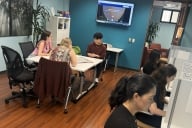You have /5 articles left.
Sign up for a free account or log in.

Weber State University hired Yudi Vargas Lewis in September 2022 to lead programs geared toward Hispanic students’ enrollment, persistence and graduation.
Weber State University
Yudi Vargas Lewis is a first-generation college graduate with a passion for supporting student success. As the executive director of Hispanic-serving institution initiatives, Lewis is responsible for working across Weber State University and its outside partners to promote enrollment, retention and graduation of the Utah university’s Hispanic and Latino student population.
Previously, Lewis served as a faculty member and program director of Latino initiatives at Utah Valley University. She also recently completed the Hispanic Association of Colleges and Universities 2021–22 Fellows of the Leadership Academy/La Academia de Liderazgo and has been recognized at the state level for her work in diversity and inclusion.
Lewis spoke with Inside Higher Ed about her work in support of Weber State’s goal of becoming an emerging HSI, community engagement and her perspective on paying it forward to the next generation.
Q: What led you to a career in higher education?
A: My parents—their desire for me to have a better life than what they had and understanding that they did not have an opportunity to even graduate from high school. My mother completed the fourth grade, and my father completed seventh grade. And there was not a single day that passed they did not remind my sisters and I that we needed to go to college. Once I was attending a higher education institution, I got the opportunity to serve on student council for about three years.
I realized the true power of education in changing lives, in transforming individuals and their future generations. So that’s why I work in higher education; that’s why I love what I do, because it has an impact. That is not just based on an individual, but future generations as well.
Q: What is your role and how does it fit into the institutional vision for serving Hispanic students?
A: I am the executive director of Hispanic-serving institution initiatives for Weber State University. It’s the only institution in the state of Utah that has it in its strategic goal to become an emerging Hispanic-serving institution by the year 2025.
Essentially, 15 percent of Utah’s population identifies as Hispanic and Latinos. By Weber State aiming to have 15 percent of its full-time degree-seeking student being Hispanic and Latino, we are simply trying to mirror the state of Utah’s population.
Another important component is that where Weber State is located up in Utah, about 30 percent of the population identifies as Hispanic and Latino, so we have a lot of work to do. Right now, Weber State has 13 percent full-time degree-seeking Hispanic and Latino students.
I think that there are a lot of factors that we already know that influence the ability for Hispanic and Latino students to have an opportunity to attend higher education in Utah and across the nation.
Q: What are some of the barriers present for Hispanic and Latino students to enroll and complete college?
A: I believe that the first barrier is a lack of information. Not having access to information on the available resources that are available to them, as they are available to all students. And then you look at financial barriers, we have many students that cannot afford to come to higher education. Our responsibility as higher education institutions, in my opinion, is that we let all students know about what are the scholarships that are available, but not only what the scholarships are, but also, how do we support them in applying for those scholarships? I think that that is a very important component—it’s not access without support is what I always say.
So we need to look at what are the services that we offer, the resources that we offer, and then also accompany that with support services, to make sure that individuals understand not only what they need to do, but that they are guided through the process.
The first strategy is simply working, collaborating with individuals across the university, in K-12 and in the community. I think that it is important to recognize [that] the work of a university to become an emerging Hispanic-serving institution, positioning to become a HSI later on, doesn’t depend on one individual, but it depends on the university as a whole. Becoming a Hispanic-serving institution in the future will benefit all students who attend Weber State, so it will empower us, enable us to be able to provide more support services, to serve all students.
Q: How do you center students in your work as an administrator?
A: That’s a great question, because I do have a lot of different responsibilities that oftentimes pull me away from that direct contact with students.
I actually both seek that contact and welcome that contact—going to events where students are involved with and supporting students in the different endeavors that they’re having on campus or serving as a mentor for Weber State University.
We have a mentoring program that includes faculty and staff. You have to opt in to be a mentor. So seeking opportunities like that, where you can actually have that one-on-one connection with students, is really important. It’s really important to me.
In our pursuit to become an emerging Hispanic-serving institution, we need to listen to our students: What is it that is important to them? What are the barriers? As you asked me before, I can give you a list of barriers, but we want to hear from our students. What is it that they want to see? And how is it that they want to be involved?
For example, this year, we were able to take—including me and the president for Weber State—five staff members and five students to the Hispanic Association of Colleges and Universities conference in Chicago, and it was a fantastic experience for our students to be able to network with about 600 students from all over the nation.
Q: You also serve as a mentor for other administrators and higher education professionals. Why is mentorship important to you?
A: I believe that, as we are gaining different experiences in, in working with students to empower them to achieve their dreams, like somebody empowered me. So I believe in paying it forward, in sharing the skill sets that I have been able to develop, so that others can do the same thing in providing opportunities for those students who might not see their own potential.
All of us can be mentors, and when we take the time to mentor someone, we’re not only giving to them, helping them develop some different skill sets or see themselves in a different perspective, but we’re bringing others to the table with us. So, again, mentoring, to me, is the ability to pay it forward in the same way that people have taken the time to do that for me.
Q: What are some of your upcoming goals?
A: I have tons of goals. Right now, we’re completing an internal asset mapping, which involves identifying different programs and resources that we provide to students, the community—and when I say “students,” [it] is K-12 students and our current students—what they find [from] that WSU experience, and then how are we connecting them to the workforce?
I’m looking at streamlining services for … not only for this student group, but also for all student populations at Weber State University, because if we are able to streamline and align services for one population, we can do the same to serve all student populations.
Something as simple as an admissions process, the experiences that students are having when they go to a website to apply for admissions to the university, is it a simple process? Are there barriers that are keeping students from applying to Weber State University? How do we eliminate those barriers? How do we eliminate the barriers and make the process as simple as possible not only for the students, but also for their families, as they’re trying to help their students navigate into college?
And another example will be streamlining what access looks like for a program that is called concurrent enrollment, or dual enrollment. That is a program available in Utah where high school students are able to take college classes while they’re attending high school. We know that the participation rate for Hispanic and Latinos in that program in the state of Utah is about 10 percent, more or less, and we want to be able to increase that number.
We also know that about 83 percent of the students who participate in concurrent enrollment in state of Utah are [white] students. So we would like to see more—we would like to streamline the ways that students have access to the information and what support they have through the application process. And then we want to be able to also make sure that the parents and guardians understand the process as well so that they can facilitate conversations at home.
If your student success program has a unique feature or twist, we’d like to know about it. Click here to submit.








